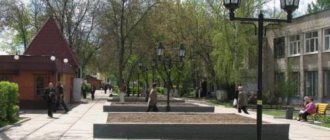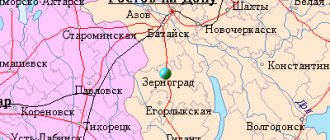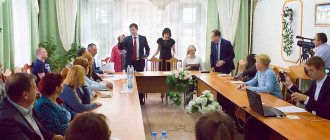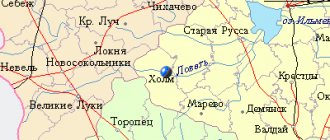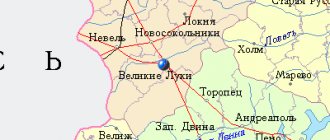Want to see a quarry that can be seen from space? Then you should go to Olenegorsk. Here you can also taste Sami cuisine, ride dog and reindeer sleds, listen to hard rock and ride a motorcycle. Fishermen willingly go to these places. Local lakes and rivers are home to carp, grass carp, pike, catfish – you can’t list them all!
In Olenegorsk you can ride a reindeer sled
City on the ore
The city of Olenegorsk is located north of the Arctic Circle, 110 kilometers south of Murmansk. It is surrounded by several lakes - Permusozero, Kolozero, Kakhozero, Krugloye, Ploskoye and Narrow. Geographically, the city is located almost in the very center of the Kola Peninsula. The relief is represented by foothills and low mountains. The climate is moderately cold. It's hard to believe, but this is a consequence of the influence of the warm Gulf Stream.
Neighborhoods of Olenegorsk
Olenegorsk is a very young city by Russian standards. In comparison with Veliky Novgorod, it can even be called a baby. It appeared on the map of the Murmansk region in 1949. Like many other cities on the Kola Peninsula, it owes its birth to geologists. In 1932, large iron ore deposits were discovered in Lapland. The deposit was named Zaimandrovskoe. The city received its name from the nearby Olenya railway station.
In fact, people lived here before. Once upon a time, the Sami settlement of Maselga stood on this site. This is not an archaeological, but a historical fact. The churchyard is mentioned in a chronicle dating back to 1574! Of course, in those days, local residents did not even think about mining iron ore. They were engaged in fishing, hunting and reindeer breeding. In the middle of the 16th century, the Kola postal route passed through Maselga from Kandalaksha to Kola. From that moment on, the residents had a new “business” - they started driving cabs.
Coat of arms of Olenegorsk
In 1916, they began to build a railway in Romanov-on-Murman - that’s what Murmansk was called in those days. Olenyu station was built on the site of Maselga. In the 30s it became a hub. Her status increased dramatically. Then it was part of the Monchegorsk region. During the Great Patriotic War, the station was under the control of Soviet troops. It was under reliable air defense protection, so it avoided destruction.
In 1949, they began to build a quarry on Olenya Hill
After the end of the war, the country needed a lot of metal. In 1949, they began to build a quarry on Olenya Hill. Soon the Olenegorsk mine appeared, which later turned into a large mining and processing plant (GOK). At the same time, the new settlement of Olenegorsk was founded, which in 1957 received the status of a city. His official birthday is December 7th. Now about 20 thousand people live in the city.
Olenegorsk
(Murmansk region)
OKATO code:
47417
Founded:
1916
Urban settlement since:
1949
City since:
1957 City of regional subordination
Telephone code (reference phone)
| 81552***** | — |
Deviation from Moscow time, hours:
0
Geographic latitude:
68°08′
Geographic longitude:
33°16′
Altitude above sea level, meters:
170 Sunrise and sunset times of the Sun and Moon in the city of Olenegorsk
City hits
At the entrances to the city you can see several memorial signs. The first of them appeared in the 60s near Olenya station. In fact, this is a huge metal sign with the inscription “Olenegorsk”. Around the same time, a composition consisting of two steles and a miner’s emblem was installed at the beginning of Leningradsky Prospekt. One of the steles is decorated with a mosaic panel.
The Ice Palace is one of the city’s calling cards
In 2004, a memorial sign was erected at the beginning of the Station Highway in honor of David Shifrin and Nikolai Zontov. It was they who discovered the iron ore deposit in the Zaimandrovsky tundra. The monument is made in the form of the outline of the Kola Peninsula. The ray of a four-pointed star points to the city.
The most impressive building in the city is the Ice Sports Palace. It was erected in 1976. At that time, it was the only sports facility on the peninsula with artificial ice. In addition to its sporting function, it plays the role of a cultural center and the main concert venue of the city. This is where all the stars touring the Murmansk region perform. The Sports Palace is the hallmark of the city.
The city has a geological rock garden
Next to the palace is the Lopark fountain. It was built in 1981, decorated with a sculptural composition - a Sami woman with two deer holding the sun in her hands above her head. The fountain was popularly nicknamed “Hello, Sun!” It works all year round and not only decorates the area, but also performs a purely practical function. In winter, water from the fountain flows into the Ice Palace and cools the artificial ice. The author of the composition is the artist Pyotr Ivanovich Danilov.
The city is surrounded on all sides by lakes
There is also a small outdoor geological exhibition near the palace. It contains 24 rocks and minerals. There is eudialyte, quartz, amethyst, amazonite and others. The samples are mounted on the wall in niches. In the city center you can see several sculptures - “Miner”, “Lyre”, “Sailboat”, “Conquerors of Space”. Beautiful mosaic on the wall of the pool building.
The city's first stone house is a historical landmark. Of course, he is still a few years old, but he is a material milestone in history. House number 5 is located on Stroiteley Street. It has only 12 apartments. During laying, a capsule was placed into the foundation. They put a list of the names of the builders in it. An inscription was made on the concrete slab: “By the will of the Communist Party and the Soviet people, the city of Olenegorsk was founded here on August 7, 1949.” Later, a memorial plaque appeared on the wall of the house.
Deer is a symbol of the city
There is a sculpture of a deer on Veterans Avenue. This animal is a symbol of the city. The sculpture was installed in 1959 in honor of the tenth anniversary of Olenegorsk. At that time the street was named after Zhdanov. The deer appeared here following the example of Monchegorsk. True, the city there is decorated with the figure of an elk. A sculptural group of deer also greets everyone who comes to the city by train. It is installed near the railway station.
The monument to Soviet times is the “Glory to Labor” stele. It has a height of 25 meters and a diameter of about one and a half meters. It's hollow inside. There are stairs leading upstairs. It is necessary to access the backlight spotlights. On the island in Komsomolskoye Lake, the high-altitude dominant feature is the monument to the unknown soldier. A monument in the form of bayonets appeared here in 1994. And the memorial “In Memory of the Fallen for the Living” is dedicated to those who died in the hot spots of the planet.
Wreaths at the monument to the unknown soldier
There are several memorial plaques in the city. One of them is dedicated to Captain Ivanov. He died in Afghanistan in 1982. Another reminds of the defenders of the Arctic. It hangs on the wall of the station. In Nadezhda Park you can see a memorial plaque in honor of the honorary citizen of the city Alexander Leonidovich Shevnin, a teacher and athlete. The memory of academician Ivan Pavlovich Bardin and Olenegorsk poet Gennady Petrovich Vasiliev is immortalized.
Ore is mined by open pit mining
As befits an industrial center, Olenegorsk has purely industrial monuments. A steel pyramid was erected on the Southern Hill in honor of the start of work at the Olenegorsk mine. And at the entrance to the Olenegorsk mining and processing plant there is a monument dedicated to the extraction of the 500 millionth ton of ore. Previously, two more monuments were erected - regarding the extraction of the 100 millionth and 200 million tons.
The temple was consecrated in honor of St. Demetrius of Prilutsky
On Polyarnaya Street there is a beautiful wooden temple. In 1994, the diocese bought a residential building in which they established a house of worship. The church was consecrated in honor of the Vologda miracle worker Dimitry Prilutsky. Two years later, the temple was completely reconstructed. Then a dome with a cross and a belfry appeared. The bells were cast in the Urals, in the city of Kamensk-Uralsky.
Several islands rise above the surface of the lake
A natural attraction in the vicinity of Olenegorsk is Lake Permusozero. It is connected to the White Sea by the Kurenga River. The lake has an elongated shape measuring 12x4 kilometers. The length of the coastline is just under fifty kilometers. Several islands rise above the water surface. The largest is considered High Voltage. Its length reaches 630 meters. In Olenegorsk, water from the lake is used as drinking water.
Home / Local governments / City administrationThe full name of the legal entity is the Administration of the city of Olenegorsk with the subordinate territory of the Murmansk region.
Legal address: 184530, Murmansk region, Olenegorsk, st. Stroitelnaya, 52.
Name: “Administration of the city of Olenegorsk with the subordinate territory of the Murmansk region.”
Phone, fax: (81552) - 58-076
Email:
Powers of the Olenegorsk City Administration:
Article 34 of the Charter of the city of Olenegorsk. Powers of the Administration of the city of Olenegorsk with its subordinate territory
1. The administration of the city of Olenegorsk with its subordinate territory is vested with the following powers:
— in the field of socio-economic development:
1) development of draft plans and programs for the socio-economic development of the municipality, local budget projects and organization of their implementation; attracting material and financial resources from other owners to implement plans and programs for the socio-economic development of the municipality;
2) formation and implementation of municipal programs for the development of small businesses;
3) participation in the development and implementation of state plans and programs on the territory of the municipality;
4) obtaining from enterprises, institutions, organizations of all forms of ownership located on the territory of the municipality, the necessary information about draft plans and measures that have environmental, demographic and other consequences affecting the interests of the population, and in cases provided for by law, the approval of such plans;
— in the field of municipal property management, relationships with enterprises and institutions:
1) management of municipal property;
2) exercise of the right of the owner of municipal property;
3) making a decision on the acceptance into municipal ownership of property transferred from federal property or from state property
Murmansk region in connection with the division of powers between public legal entities;
4) establishment, reorganization and liquidation of municipal enterprises and institutions, hearing reports from the heads of municipal enterprises, institutions and other organizations on their activities;
5) promoting the creation on the territory of the municipality of enterprises of various forms of ownership engaged in servicing the population, the creation of peasant (farm) farms;
6) concluding agreements with enterprises and organizations on cooperation in the economic and social development of the municipality, agreements for the production of consumer goods and other products, and the provision of services;
— in the field of land relations:
1) management and disposal of land plots in municipal ownership;
2) management and disposal in accordance with the legislation of state-owned land plots, before the delimitation of state ownership of land;
3) reservation of lands, seizure, including through redemption, of land plots for municipal needs;
4) development and implementation of local programs for the use and protection of lands, as well as other powers to resolve issues of local importance in the field of use and protection of lands;
5) implementation of land control over the use of municipal lands;
— in the field of urban planning:
1) preparation of documents for territorial planning of the urban district;
2) issuance of construction permits, permits to put objects into operation during construction, reconstruction, capital
repair of capital construction projects located on the territory of the urban district;
3) maintaining information systems for supporting urban planning activities carried out on the territory of the urban district;
4) approval of territory planning documentation prepared on the basis of master plans;
5) approval of local urban planning standards;
— in the field of housing relations and housing and communal services:
1) accounting of municipal housing stock;
2) maintaining, in accordance with the established procedure, registration of citizens as those in need of residential premises provided under social rental agreements;
3) determining the procedure for providing residential premises of the municipal specialized housing stock;
4) provision, in the prescribed manner, to low-income citizens under social tenancy agreements of residential premises of the municipal housing stock;
5) making decisions in the prescribed manner on the transfer of residential premises to non-residential premises and non-residential premises to residential premises;
6) coordination of reconstruction and redevelopment of residential premises;
7) recognition, in accordance with the established procedure, of residential premises of the municipal housing stock as unsuitable for habitation;
 exercising control over the use and safety of the municipal housing stock, the compliance of the residential premises of this stock with established sanitary and technical rules and regulations, and other legal requirements;
exercising control over the use and safety of the municipal housing stock, the compliance of the residential premises of this stock with established sanitary and technical rules and regulations, and other legal requirements;
9) determining the procedure for obtaining a document confirming the decision to approve or refuse approval of the reconstruction and (or) redevelopment of residential premises in accordance with the conditions and procedure for the reconstruction and redevelopment of residential premises;
10) organization of public services for the population, sustainable operation of water supply, gas supply, heat supply, energy supply, taking measures to provide the population and municipal institutions with fuel;
11) organization of funeral services, ensuring proper maintenance of cemeteries and other burial places;
12) other issues in accordance with the Constitution of the Russian Federation, the Housing Code of the Russian Federation, other federal laws, as well as the laws of the Murmansk region;
— in the field of relations related to environmental protection:
1) organization of environmental protection measures within the boundaries of the urban district;
2) organization of collection, removal, disposal and processing of household and industrial waste;
3) exercise powers in the field of environmental assessment in accordance with the legislation of the Russian Federation;
— in the field of improvement of the urban district:
organization of improvement and landscaping of the territory of the municipality, use, protection, protection, reproduction of urban forests, forests of specially protected natural areas located within the boundaries of the urban district;
— in the field of communications, consumer and trade services:
1) creation of conditions for providing the population with communication services, trade, public catering and consumer services for the population in the subordinate territory;
2) execution of powers established by legislation on the protection of consumer rights;
— in the field of transport transportation:
1) creation and maintenance of municipal motor transport fleets and the acquisition of transport to resolve issues of their competence and carry out local and freight transportation;
2) coordination of routes and schedules for local passenger transportation in the jurisdiction;
3) creation of conditions for the provision of transport services and organization of transport services;
4) road activities in relation to local roads in the urban district, as well as the exercise of other powers in the field of use of roads and implementation of road activities in accordance with the legislation of the Russian Federation;
- in the healthcare sector:
organization of the provision of primary health care on the territory of the urban district in outpatient clinics, inpatient clinics and hospitals, emergency medical care (except for air ambulance), medical care for women during pregnancy, during and after childbirth;
- in the field of education:
1) organization of the provision of publicly available and free primary general, basic general, secondary (complete) general education in basic general education programs, with the exception of the powers to financially support the educational process, which are assigned to the powers of public authorities of the Murmansk region;
2) organizing the provision of additional education to children (except for the provision of additional education to children in institutions of regional significance) and publicly available free preschool education, as well as organizing recreation for children during the holidays;
3) creation, reorganization and liquidation of municipal educational institutions;
4) ensuring the maintenance of buildings and structures of municipal educational institutions, arrangement of territories adjacent to them;
5) registration of children subject to compulsory education in educational institutions implementing educational programs of primary general, basic general and secondary (complete) general education;
— in the field of social support of the population:
organization, at the expense of own and borrowed funds, of additional social support for the population, in excess of that established by law and government programs;
— in the field of development of culture, physical culture and sports:
1) organization of library services to the population, acquisition and preservation of library collections of city district libraries;
2) creating conditions for organizing leisure time and providing residents of the municipality with the services of cultural organizations;
3) creating conditions for the development of local traditional folk art, participation in the preservation, revival and development of folk art in the urban district;
4) preservation, use and popularization of cultural heritage objects (historical and cultural monuments) owned by the urban district, protection of cultural heritage objects (historical and cultural monuments) of local (municipal) significance located on the territory of the urban district;
protection of historical and cultural monuments of local significance located on the territory of the urban district;
5) providing conditions for the development of physical culture and mass sports on the territory of the urban district, organizing official physical culture, health and sports events of the urban district;
6) creating conditions for mass recreation for residents of the municipality and organizing the arrangement of places for mass recreation of the population;
7) organization and implementation of activities to work with children and youth in the city district;
— in the field of fire safety:
1) provision of primary measures for the organization of voluntary fire protection, as well as for the participation of citizens in ensuring primary fire safety measures in other forms;
2) inclusion of measures to ensure fire safety in plans, schemes and programs for the development of the territory of the urban district;
3) providing assistance to public authorities of the Murmansk region in informing the population about fire safety measures, including through organizing and holding public meetings;
4) establishment of a special fire regime in case of increased fire danger;
— in the field of ensuring the rule of law, protecting public order, rights and freedoms of citizens:
1) creation and financing of municipal police in accordance with current legislation;
Everything for tourists
The city has a museum and exhibition hall “At the Deer Mountain”. The permanent exhibition includes an exhibition of Sami arts and crafts. There is a section dedicated to the history of the city and the mining and processing plant. “Amazing stones”, “The path of a geologist. Life and work of A.E. Fersman”, “They built our city” - the names of the exhibitions speak for themselves.
The museum has a section “Amazing Stones”
The museum regularly hosts folklore and ethnographic evenings “In a warm cozy tent”, “Christmas gatherings” and others. Visitors are taught carols and ritual songs, and treated to national cuisine. Adults and children participate in theatrical performances. Every year on February 6, International Sami Day, the exhibition “Sami Patterns” is organized. It presents handmade items. Rotating photo and art exhibitions are held regularly.
In the Sami plague
The city-forming enterprise is the Olenegorsk mining and processing plant. In Russia it is considered the northernmost producer of iron ore concentrate. Ore is mined in six quarries. Olenegorsky is considered the largest. Its depth reaches 400 meters. For comparison, the maximum depth of the Azov Sea does not exceed 14 meters. Excursions are organized to the plant’s work site, during which you can observe the mining equipment in action.
You can get acquainted with the Olenegorsk Mining and Processing Plant during a tour
Near Olenegorsk lies the Simbozersky reserve. Its task is to protect rare animals of the Kola Peninsula. Here, in particular, are the wintering grounds of moose. The reserve is even called a maternity hospital for moose. Visitors are offered excursions, as well as trips on ATVs and snowmobiles. Hunting in the reserve is prohibited, but picking mushrooms and berries is allowed.
Wintering grounds for moose are located in the Simbozersky Nature Reserve.
During the year, Olenegorsk hosts seven festivals. The “track” is designed for young people. This is breakdancing, rap, rock, art song and folklore in one “bottle”. January is the time of the New Year's festival "Morozko". The fact is that in 1964, the famous film “Morozko” was filmed in the outskirts of the city. Hence the name of the holiday. The townspeople then took part in the crowd scenes. The director of the local sports complex even acted as a stunt double.
In February there is a soldier's song competition. It is dedicated to the anniversary of the withdrawal of Soviet troops from Afghanistan. The festival of Sami music and culture falls in April. The program includes national songs, dances, reindeer riding, and an exhibition of handicrafts. The Gates of the Sun festival starts in mid-May. It is dedicated to Slavic writing. On this day, all kinds of master classes take place on the square. In August, the rock festival “METALurg” thunders, and in September the “Three Mountains” motorcycle competition starts.
Seven festivals are held in Olenegorsk throughout the year.
You can stay overnight in Olenegorsk at the only hotel “Gornyak”. A more economical, but spartan option is the Shakhtar hostel. The Ice Palace has guest rooms. The best option is to rent an apartment in the city center. There are also hotels in the neighboring city of Monchegorsk.
You can have fun and have a snack at the same time in the “Territory” art hall. Guests have at their disposal a kicker, table tennis, Monopoly game, and air hockey. The popular cafes are “Veranda”, “Drova”, “Three Sauces”, “Yin-Yang”.
Visiting the Sami
On the site of Olenegorsk there was once a Sami settlement. Alas, now you hardly see Sami in the city. To get acquainted with the life of the aborigines of the Kola Peninsula, you can go to the Oleniy Bereg agricultural village. It is located 10 kilometers from the city on the shores of Lake Hare. Deer, huskies, rabbits - it's all here. You can ride deer and dogs. There is a guest house. Visitors are offered trips on ATVs and snowmobiles. In these places you can really see the northern lights.
You can go dog sledding in the agricultural village
Another interesting place associated with the Sami is located in the village of Lovozero, 84 kilometers from Olenegorsk. The open-air museum “Sam Syyt” is located here. In fact, it is a recreated Sami village. Tourists are offered a three-hour excursion. The program includes a visit to traditional Sami buildings - tents, vezhi, kuvaks. On the alley of idols, guests make wishes.
Sami ethnographic complex
There is a mini-zoo on the territory where moose, huskies, foxes, arctic foxes and rabbits live. Animals are fed by hand. In summer, guests visit the picturesque spring lake “Seven Springs of the Sami”. You should definitely play the national Sami games - pole tug-of-war, “deer and wolves”, reindeer antler throwing and others.
In winter, the excursion includes riding a reindeer sleigh or riding a snowmobile in a sleigh. There is an opportunity to ride with the breeze on a “banana”, which is attached to a snowmobile. Or fly down the slide on the ice. In summer, ATVs are used as a means of transport. At the Petroglyphs cafe they serve lim (salmon fish soup), the Sami drink “pakula” and Lovozero bread. You should definitely try “kull-värr” - floury fish soup.
Those interested can take pictures in national clothes
Those who wish can take pictures in national Sami clothing. Tourists buy amulets and charms as souvenirs. There is a guest house and apartments in the village. There is a sauna for six people. Fishing and picnics can be organized for guests. Cost of the excursion: adults – 1550 rubles, children – 1300 rubles.

